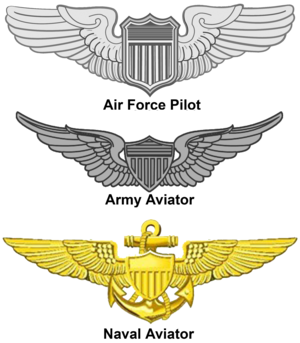United States Aviator Badge
| United States Aviator Badge | |
|---|---|
 | |
| Typ | Badge |
| Status | Currently awarded |
| Established | Second World War |
| Army Precedence | |
| Next (higher) | (Group 2 badges) CMB - EFMB |
| Equivalent | (Group 3 badges) Astronaut - EOD - Aviator - Flight Surgeon - Aircrew |
| Next (lower) | (Group 4 badges) Parachutist, Air Assault, Military Freefall Parachutist |
A United States Aviator Badge refers to three types of aviation badges issued by the United States military, those being for Army, Air Force, and Naval aviation.
In the modern military, Army and Air Force Aviator Badges are issued in three ratings: Basic, Senior, and Command/Master/Chief. The higher degrees are denoted by a star or star with wreath above the badge. Air Force regulations state that the basic rating denotes completion of specified training and that the advanced ratings denote experience levels. The Naval Aviator Badge is issued in a single rating for the Navy, Marine Corps, and Coast Guard.
US Army
The first United States Aviator Badges were issued to members of the Air Service during the First World War. The badges were issued in three degrees: Observer (a "US" shield and one left-side wing), Junior Aviator or Reserve Aviation Officer (a "US" shield between two wings), and Senior Aviator (a star over "US" shield between two wings). The Army Air Corps also issued a badge for balloon pilots, known as the Aeronaut Badge.
Enlisted Aviators wore their regular rank insignia and the Observer's badge. There were 29 enlisted pilots before the American entry into World War One. The second enlisted aviator, William A. Lamkey, got a discharge and flew for Panco Villa. The remaining enlisted pilots received commissions in 1917. There were 60 enlisted mechanics who were trained as pilots in France during the war, but they were used for ferrying duties and did not fly in combat.[1]
During the Second World War, with the rise of the Army Air Forces, a second series of aviator badges were issued to include a design that has survived to the modern day. The Army Air Corps Pilot Badge was issued in three degrees, including Pilot, Senior Pilot, and Command Pilot. A polished silver colored version of these badges is currently used as the United States Air Force Pilot Badges. The Enlisted Aviator Badge was eliminated, since the new pilot corps was composed entirely of officers.
US Air Force
After the creation of the Air Force as a separate service in 1947, Army aviation continued to a degree that warranted a new badge for Army Aviators. The result was the creation of the Army Aviator Badge, which is a modified version of the U.S. Air Force Pilot Badge. It comes in three grades: Basic, Senior (7 years service and 1,000 flight hours), and Master (15 years service and 2,000 flight hours[2]. The Aviator and Senior Aviator Badges were approved on 27 July 1950 and the Master Aviator Badge was approved on 12 February 1957. Army Aviator's Badges are dull silver in color.
US Navy, US Marine Corps and US Coast Guard
The aviator badge currently used in the Navy has remained virtually unchanged since it was first issued on 13 November 1917. The Naval Aviator Badge is earned by all U.S. Navy, Coast Guard, and Marine Corps pilots upon graduation from advanced flight schooling. Naval Aviators' badges are gold in color.

NASA
With the dawn of the Space Age, all of the United States Aviator badges are upgradable to the Astronaut Badge, for those military pilots who become astronauts.
See also
- Badges of the United States Air Force
- Badges of the United States Army
- Badges of the United States Coast Guard
- Badges of the United States Marine Corps
- Badges of the United States Navy
- Aircrew Badge
- Astronaut Badge
- Auxiliary Pilot Badge
- Flight Officer Badge
- Naval Aviator Badge
- Navigator Badge
- Observer Badge
- Military badges of the United States
- Obsolete badges of the United States military
